Reducing nitrogen fertilization of intensive kiwifruit orchards decreases nitrate accumulation in soil without compromising crop production
LU Yong-li , KANG Ting-ting GAO Jing-bo CHEN Zhu-jun ZHOU Jian-bin
1 College of Natural Resources and Environment, Northwest A&F University/Key Laboratory of Plant Nutrition and the Agri-Environment in Northwest China, Ministry of Agriculture, Yangling 712100, P.R.China
2 College of Resources and Environmental Sciences, Gansu Agricultural University, Lanzhou 730070, P.R.China
1. Introduction
Nitrogen (N) is an essential macronutrient for plants and plays a significant role in crop production (Tilmanet al.2011). More than half of the global population is fed by crops grown with the use of synthetic N fertilizers (Erismanet al.2008; Zhanget al.2015a). China is the largest consumer of synthetic fertilizers and uses about one third of the world’s fertilizer (Zhanget al.2011; FAO 2014). However,only about half of the N fertilizer applied to soil is typically consumed by crops, while the other half either remains in soil or is lost from fields into the water and atmosphere(Davidsonet al.2015), which poses a series of health and environmental problems globally (Gallowayet al.2013).
The area of agricultural land in China devoted to fruit and vegetable production has increased rapidly since the 1990s, increasing from 9.3% in 1990 to 20.2% in 2010, due to their high economic benefit (Zhanget al.2015b). The use of synthetic fertilizers for growing horticultural crops is particularly high. The average N input to orchards in China was as high as 869 kg N ha–1yr–1in 2008 (Xinet al.2012). As a result, horticultural crops consume nearly 30% of the total synthetic fertilizers in China (IFA 2013;De Rosaet al.2016). This results in a very low nitrogen use efficiency (NUE); the global average NUE is 0.14 for fruit and vegetables, but in China it is only about 0.10 (Zhanget al.2015a).
Excessive application of N fertilizer results in large amounts of nitrate-N accumulation in soil (Zhouet al.2016).This residual nitrate-N is not adsorbed by soil because,like soil colloids, it is negatively charged. Therefore, it is easily leached into deep soil layers when heavy rains and flood irrigation occur (Aulakh and Malhi 2005; Zhouet al.2016). Juet al.(2006) reported that about 99% of the ground water samples in shallow wells (<15 m depth) under horticultural crop systems were heavily contaminated, and this was associated with the excessive N fertilization. Overfertilization has also resulted in severe soil acidification (Guoet al.2010; Cuiet al.2013) and secondary soil salinization(Juet al.2007). In addition, high N inputs also degrade fruit quality (Prasad and Spiers 1991). Therefore, there is an urgent need to reduce the amount of N fertilizer being used in horticultural systems to address the problems associated with overuse of N fertilizer. In addition, reducing N fertilizer use can reduce the cost to farmers.
Kiwifruit (Actinidia deliciosa) cultivation in China has developed very fast in the past three decades, especially in the northern slope region of the Qinling Mountains in Shaanxi Province, China. This area covers nearly 30% of the total area planted with kiwifruit worldwide and 60% of the land used to grow kiwifruit in China (Luet al.2016a).Our previous survey found that the average N fertilizer application rate to kiwi orchards in this region was around 900 kg N ha–1yr–1, which is well above the recommended rates (350–500 kg N ha–1yr–1) (Luet al.2016b). In this area, abundant rainfall and the use of flood irrigation in the summer increases the risk of nitrate-N loss through leaching (Zhouet al.2006, 2016). However, a very limited number of studies have evaluated the effects of reduced N application rate on kiwifruit production, quality, and economic and environmental benefits. Furthermore, some studies have shown that using controlled-release N fertilizer is an efficient way to reduce N loss and increase N use efficiency(NUE) because it controls the rate of nutrient release (Wang Y Het al.2011; Zhuet al.2012; Sui and Zhang 2014). But the application of controlled-release N fertilizers, such as controlled-release urea (CRU), in a kiwifruit orchard system has so far not been thoroughly evaluated.
Therefore, field experiment was conducted in three successive years to compare the effects of conventional N fertilization, reduced N fertilization, and different N forms(urea (U) and CRU) on kiwi vine production and nitrate accumulation in soil. The specific objectives of the study were (1) to compare the effects of different N application rates on N content in different kiwi vine organs, the yield and quality of kiwifruits and economic benefits, (2) to compare the effectiveness of CRU and U, and (3) to determine the accumulation and potential loss of nitrate-N within the soil profile.
2. Materials and methods
2.1. Study site
The study was conducted from October 2012 to October 2015 in Zhuyu catchment, Zhouzhi County (33°42´–34°14´N,107°39´–108°37´E), Shaanxi Province, China. This area is located in a major kiwifruit producing region in the northern slope region of the Qinling Mountains, which is characterized by a warm-temperate, semi-humid, continental, and monsoon climate. The average annual temperature is 13.2°C. The mean annual precipitation is 660 mm, with approximately 70% falling from July to September. The monthly precipitation, reference crop evapotranspiration(ET0), and irrigation events during the study years are shown in Fig. 1. The soil in the orchard is classified as a cinnamon soil (Ustalf in the USDA system). The major physical and chemical properties of the soil at depths ranging from 0–100 cm before the experiment are shown in Table 1.
The traditional crops in the catchment were winter wheat(Triticum aestivumL.) and summer maize (Zea maysL.).After the 1990s, farmers began to plant kiwi vines due to their higher profitability, and kiwifruits became the main crop in the catchment. The kiwi vines are trained on a T-bar trellis system and have a density between 1 667 and 2 220 vines ha–1. The area of each kiwifruit orchard in the catchment is usually smaller than 0.15 ha.
2.2. Field management and experimental design
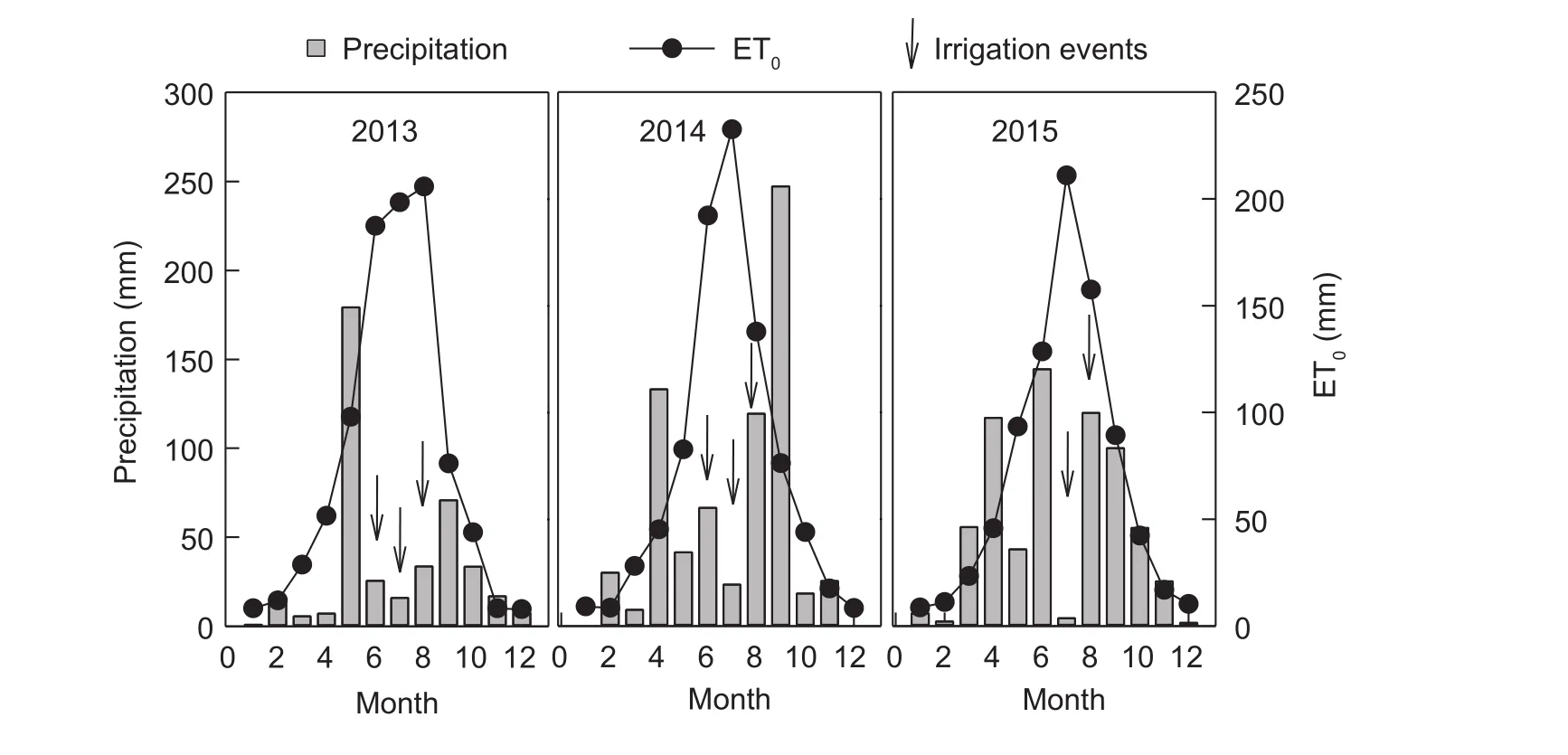
Fig. 1 Monthly precipitation, reference evapotranspiration (ET0), and irrigation events from 2013 to 2015 in the study region.

Table 1 Main physical and chemical properties of the soil at depths ranging 0–100 cm at the start of the experiment
Our field experiment was carried out in a farmer’s kiwifruit orchard in the study catchment. The kiwi vines were planted in 2003 with a row-row and plant-plant spacing of 3.0 and 2.0 m, respectively. There were three treatments, i.e., the conventional farmer N fertilization rate (900 kg N ha–1as urea) (CF-U), which was determined from a survey we did in this catchment before the experiment (Luet al.2016b),and two reduced N application treatments. To convince the farmer to cooperate with us, we did not reduce the N fertilizer rate to the recommended rates directly. Instead,we reduced N rate year by year, i.e., by 25% reduced N application as compared to farmer’s rate in 2013 and 2014,and by 45% in 2015.
The reduced N application treatments were applied as U (–N-U) and CRU (–N-CRU). The –N-U treatment was applied in three separate doses; 30% was applied as the basal dose, 50% was applied at the bud enlargement stage and 20% was applied at the fruit enlargement stage. The CRU, which was polymer-coated urea with a release period of 3–4 months, was applied in two separate doses; 30% was applied as the base, and the remaining 70% was applied at the bud enlargement stage. All treatments had three replications, and a completely randomized block design was used. Plot sizes were 4 m×6 m with a 50-cm isolation belt, and each plot consisted of four kiwi vines.
Organic fertilizers, phosphorus and potassium fertilizer were applied at the same rate in each treatment. All organic fertilizer and phosphorus fertilizer were applied as a basal dose. The application ratio and timing of potassium fertilizer application were consistent with U application. The details of each treatment are shown in Table 2. Except for differing N management, the farming practices (weeding, watering,pruning, disease, and pest insect prevention) used in kiwi orchards were consistent with the practices of local farmers.
2.3. Sampling and analysis
Leaf samples were collected monthly from the middle of the new shooting branches from May to October in 2014 and from April to October in 2015. Approximately 60 leaf samples were taken from each plot and put into paper bags.These samples were immediately cleaned in the laboratory,dried at 60–70°C, and ground into powder (0.25 mm). The samples were digested with H2SO4and H2O2, and total N was determined following the Kjeldahl method (Bao 2000).
Soil profile samples (0–200 cm) were taken each year in early October after kiwifruit harvesting. Soil samples were collected from four sites with an auger (inner diameter4.0 cm) at 20 cm intervals at depths ranging 0–200 cm,and samples collected from the same layer in the same plot were mixed, sealed and stored at 4°C. The fresh soil samples were divided into two sub-samples. One was used to determine soil nitrate-N concentration, and the other was air-dried for the analysis of soil electric conductivity(EC). The fresh soils were extracted with 1 mol L–1KCl(soil:solution ratio, 1:10, soil/water) by shaking for 1 h,and the nitrate-N content in the extract was determined using a continuous flow analyzer (Bran and Luebbe AA3,Norderstedt, Germany). Soil EC was measured using a conductivity meter as described by Rhoades (1996).
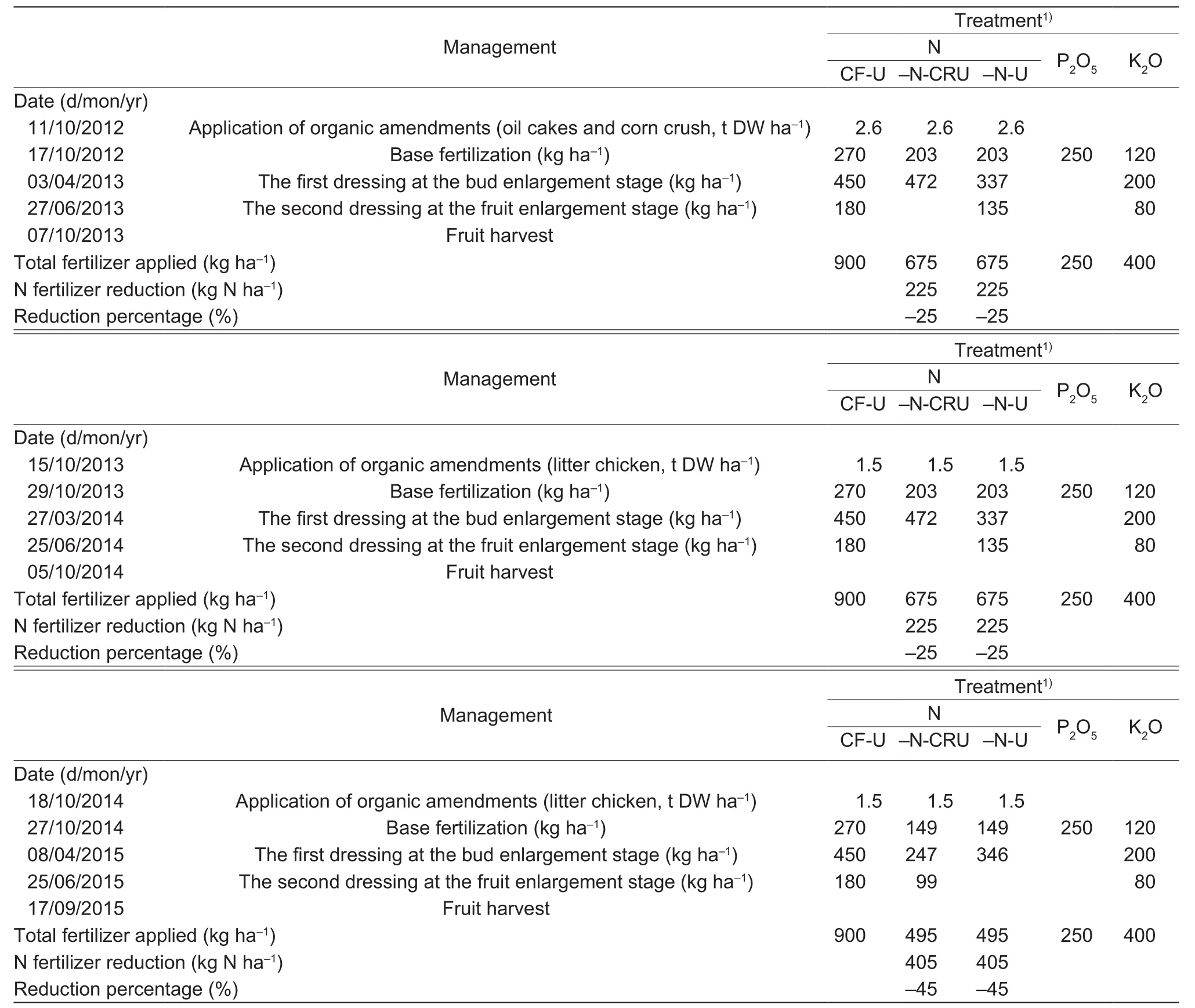
Table 2 Experimental design and details about N fertilization management for different treatments
All fruits from each vine in each plot were collected and weighed at harvest each year (early October). At the same time, the number of fruits on each vine was also counted to calculate the single-fruit weight. Fifteen fruits were taken from each plot to determine nutrient concentration and the quality index. Fruit samples were cut into small pieces,dried at 60–70°C, and crushed into powder (0.25 mm). Fruit quality indicators including total soluble solids content (TSS),titratable acidity (TA), vitamin C, and soluble sugar content were determined. Approximately eight fresh pieces derived from eight randomly selected fruit samples were blended together, and the juice was used for analysis of TSS, TA and soluble sugar content. TSS was determined using a hand-refractometer and expressed as Brix (%). TA in the same diluted juice solution was determined by titrating 10 g juice with 0.1 N NaOH to a target pH value of 8.2. Soluble sugar content was determined according to the method of Dubois (1951). Ascorbic acid content was determined using 2,6-dichloroindophenol (DCIP) (AOAC 1990).
2.4. Calculation method
PFPN(kg fruits kg N–1) was calculated as the ratio of fruit yield (kg fruits ha–1yr–1) to applied N (kg N ha–1).
Nitrate-N accumulation (NA, kg N ha−1) in the soil layer was calculated as:
NA=(BD×d×C)/10
Where, BD,d, andCrefer to soil bulk density (g cm−3),depth of the soil layer (cm), and soil nitrate-N concentration(mg N kg−1), respectively. The mean BD in 0–60 cm soil depths at each 20-cm interval was showed in Table 1. The BD for the 60–200 cm soil layer was considered to be the same as for the 40–60 cm layer, due to the reported small variations of BD in deep soils (Luet al.2016a).
Considering the differences between the rates and frequencies of N fertilizer application among the treatments,we kept the other practices in the orchard constant.Therefore, the economic benefit of the orchard was estimated by subtracting the costs of production (mainly due to the cost of fertilizers and fertilization labor costs) from the gross income obtained from fruit yield.
2.5. Statistical analysis
All data were organized and calculated using Excel 2007,and the figures were drawn in SigmaPlot 12.0 (Systat Software, Inc.). Differences in kiwifruit yield, fruit quality,nitrate-N distribution and accumulation, PFPNand economic benefits among the different treatments were tested by analysis of variance using SAS version 9.0, and the least significant difference (LSD) test was used for post hoc tests.P<0.05 was considered significantly different.
3. Results
3.1. Nitrogen (N) content in different kiwi vine organs
N concentration in leaves declined during both the 2014 and 2015 growing seasons (Fig. 2-A and B). However, there were no significant differences among the three treatments in either year (P>0.05) (Fig. 2-A and B). There were also no significant differences in total N content of fruits and pruning branches between treatments in both 2014 and 2015 (Fig. 2-C and D,P>0.05).
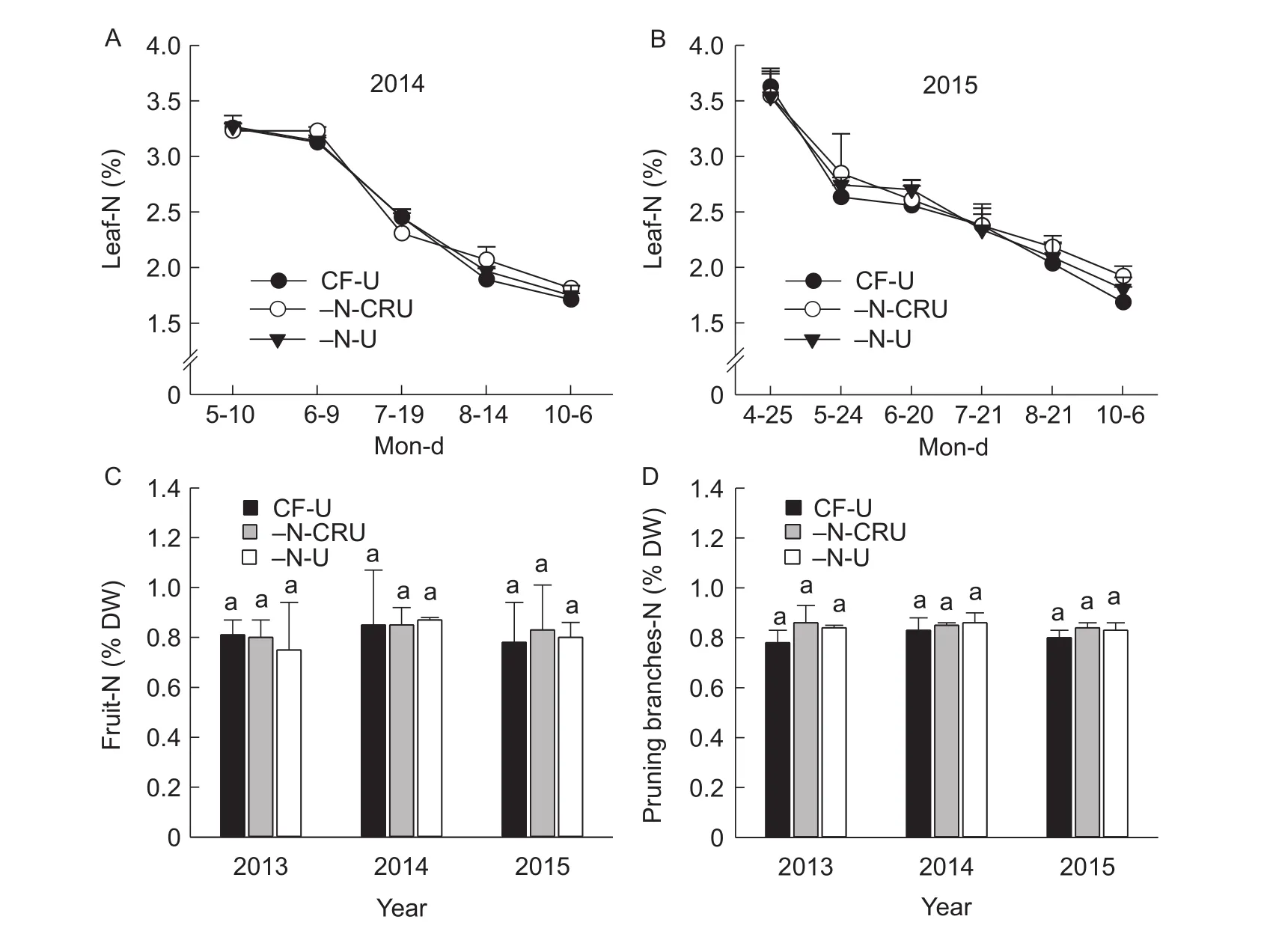
Fig. 2 Changes in the leaf-N concentration under different treatments during the growing season in 2014 (A) and 2015 (B), and changes in fruit-N (C) and pruning branches-N (D) concentrations under different treatments in 2013, 2014 and 2015. CF-U,conventional N fertilizer rate (900 kg N ha–1 yr–1) added as urea (46% N); –N-CRU and –N-U refer to treatments where N was applied as controlled release urea and urea, respectively. In both treatments, the rates of N application were reduced by 25% in 2012–2013 and 2013–2014, and by 45% in 2014–2015, respectively. Different letters at the same soil depth indicate significant differences at P<0.05. Bars indicate SD.
3.2. Single-fruit weight, fruit yield, and quality
Compared to the CF-U treatment, reducing the N application rate by 25% in 2012–2013 and 2013–2014 and by 45% in 2014–2015 did not have a significant effect on single-fruit weight and fruit yield (P>0.05). And there were also no significant differences between the two types of N fertilizer treatments (–N-CRU or –N-U) (Fig. 3). The reduced N fertilization treatments also did not significantly affect fruit quality during the study (Table 3,P>0.05).
3.3. N partial productivity (PFPN) and economic benefits
Reduced N fertilizer treatments significantly increased PFPNduring the study period (Fig. 4). The average PFPNacross the 2012–2013 and 2013–2014 growing seasons for the CF-U treatment was only 43 kg kg–1, but average PFPNwas 75.2 and 80.7 kg kg–1for the N-CRU and N-U treatments,respectively (P<0.05). PFPNin 2014–2015 was significantly higher under the N-CRU (83.2 kg kg–1) and N-U (91.0 kg kg–1) treatments compared with the CF-U (46.1 kg kg–1)treatment (P<0.05). There was no significant difference in PFPNbetween the N-U and N-CRU treatments (P>0.05).
Reducing the N application rate by 25% in 2012–2013 and 2013–2014, and by 45% in 2014–2015 slightly increased the economic benefits to farmers (Table 4). Additionally,although the labor cost of fertilizer application was reduced because CRU was only applied twice, due to the high price of CRU, the economic incomes for CRU treatments were slightly lower than for U treatments applied at the same rate.
3.4. Nitrate-N content and electrical conductivity in soil profiles

Fig. 3 Single fruit weight (A) and yield (B) under different N treatments in 2013, 2014 and 2015. CF-U, conventional N fertilizer rate (900 kg N ha–1 yr–1) added as urea (46% N); –N-CRU and –N-U refer to treatments where N was applied as controlled release urea and urea, respectively. In both treatments, the rates of N application were reduced N by 25% in 2012–2013 and 2013–2014,and by 45% in 2014–2015, respectively. Different letters at the same soil depth indicate significant differences at P<0.05. Bars indicate SD.

Table 3 Values of fruit quality parameters for the different N treatments during the experimental period
The two reduced N fertilization treatments decreased soil nitrate-N concentrations in comparison with the CF-U treatment in 2013 to 2015 (Fig. 5-A–C). Compared to –N-U,the –N-CRU treatment increased nitrate-N concentrations in soil at depths ranging 0–100 cm during all three years(Fig. 5-A–C). The total nitrate-N accumulation in soil at depths ranging from 0–200 cm under the reduced N treatments was significantly lower in comparison with the CF-U treatment (Fig. 5-D–E). During 2012 to 2014, the average nitrate accumulation in soil at a depth of 0–200 cm was 1 184, 955, and 775 kg N ha–1under the CF-U,–N-CRU, and –N-U treatments, respectively(P<0.05).When reducing N application rate by 45% in 2014–2015,nitrate accumulation in soil at a depth of 0–200 cm reached 1 462, 1 321 and 852 kg N ha–1under the CF-U, –N-CRU and –N-U treatments, respectively(P<0.05). The nitrate-N accumulation under the CRU treatment was higher than that under the U treatment, especially at a depth of 0–100 cm (Fig. 5-D–E).
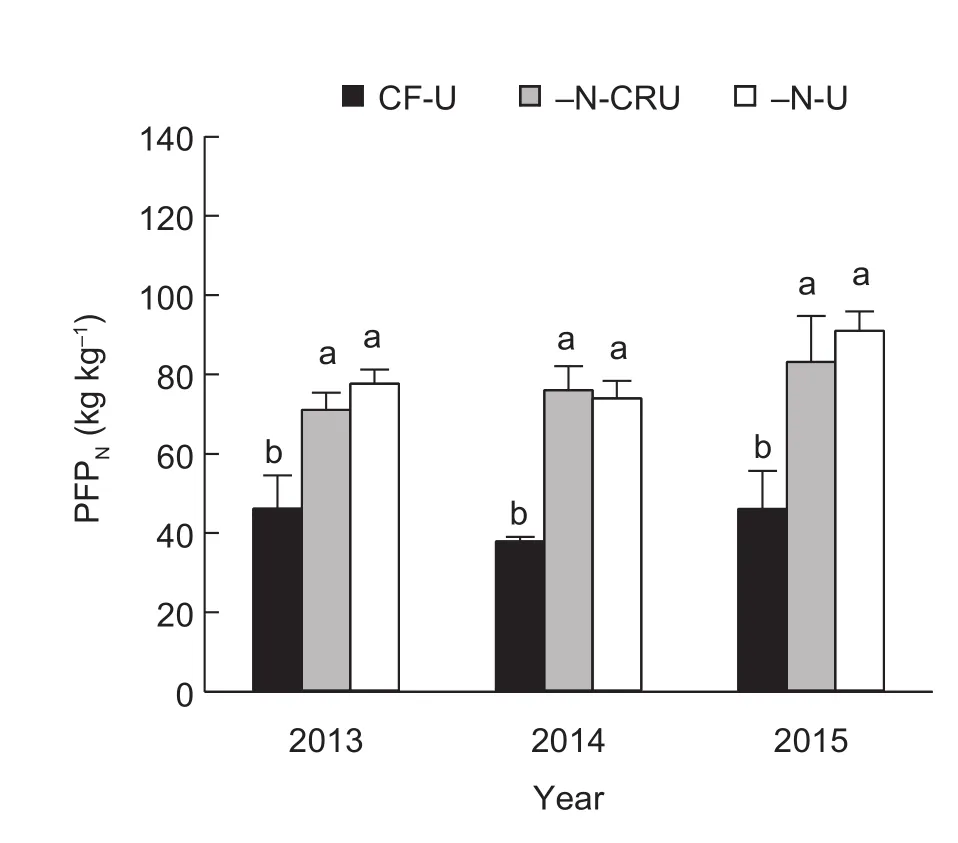
Fig. 4 PFPN (the partial factor productivity of N, kg of fruit per kg N) under different treatments in 2013, 2014 and 2015. CFU, conventional N fertilizer rate (900 kg N ha–1 yr–1) added as urea (46% N); –N-CRU and –N-U refer to treatments where N was applied as controlled release urea and urea, respectively.In both treatments, the rates of N application were reduced by 25% in 2012–2013 and 2013–2014, and by 45% in 2014–2015,respectively. Bars indicate SD. Different letters in the same year indicate significant differences at P<0.05.
The change in soil EC under all treatments was similar to that observed for nitrate-N concentrations within the 0–200 cm soil layer in 2014 and 2015 (Fig. 6). Regression analysis further indicated a significant linear relationship between soil EC and nitrate-N concentration (Fig. 7).
4. Discussion
4.1. Excessive application of N fertilizer in kiwifruit production
Our three-year field experiment indicated that compared with conventional N fertilization (CF-U), reducing the N application rate by 25% in the first two years did not decrease fruit yield and single-fruit weight, and it also had no adverse effects on the N nutrition of kiwi vines (leaf-N,pruning-N and fruit-N) (Fig. 2) and fruit quality (Table 3).Similar results were observed when the N rate was reduced by 45% in the third year. This demonstrates that N fertilization in kiwi orchards in the region is excessive,which is consistent with observations from previous survey studies (Zhaoet al.2014; Luet al.2016a). The reduced N fertilization treatments also markedly increased the PFPNand significantly decreased nitrate-N accumulation in soil profiles. Thus, our study confirms that reducing N fertilizerrates is an effective way to reduce nitrate accumulation in soil without compromising kiwifruit growth, yield and quality.

Table 4 The economic benefits of kiwifruit production under different N fertilization treatments in 2012–2014 and 2014–2015
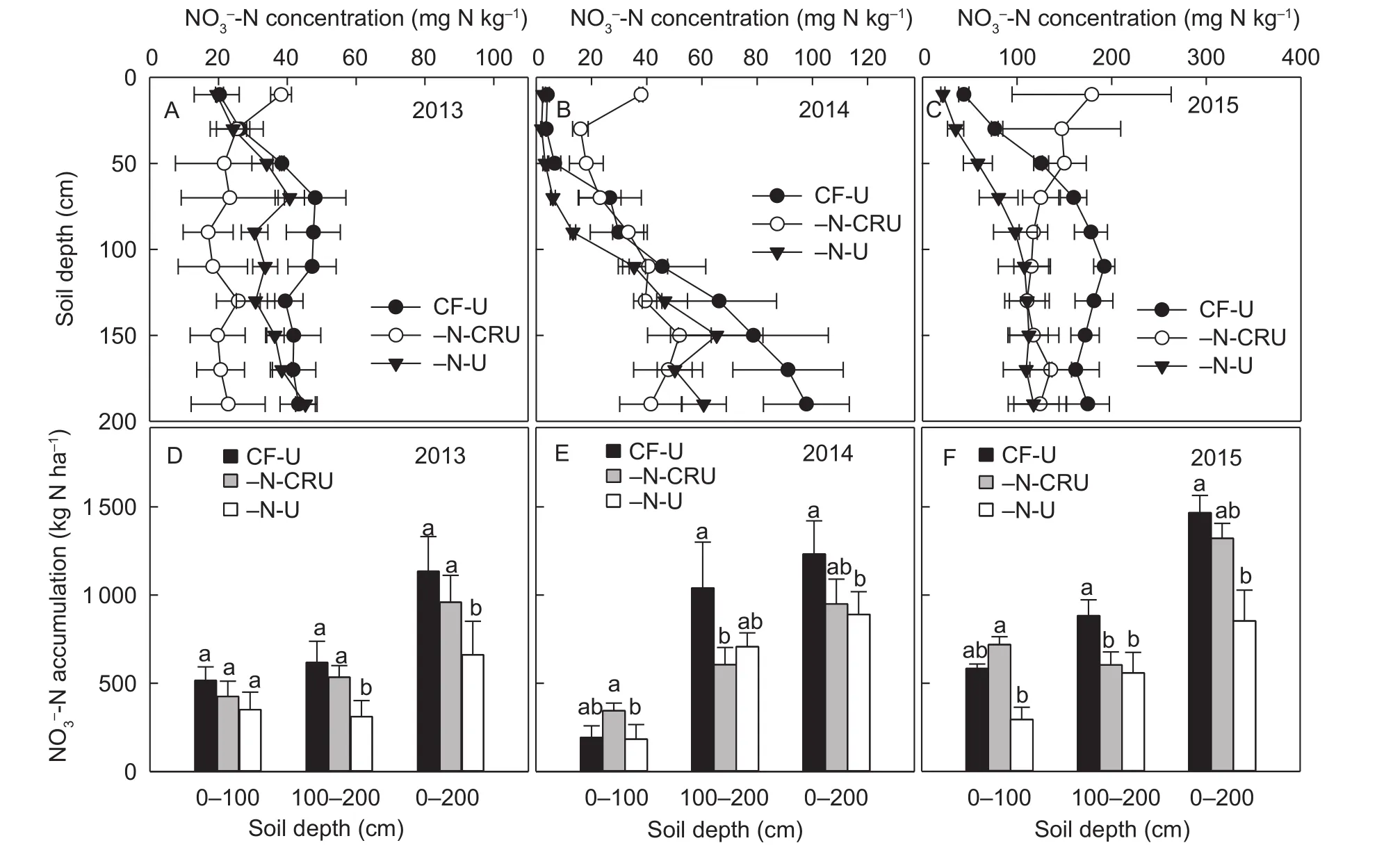
Fig. 5 The distribution (A–C) and accumulation (D–F) of nitrate-N in the soil profile at the end of the growing season in 2013, 2014 and 2015. CF-U, conventional N fertilizer rate (900 kg N ha–1 yr–1) added as urea (46% N); –N-CRU and –N-U refer to treatments where N was applied as controlled release urea and urea, respectively. In both treatments, the rates of N application were reduced by 25% in 2012–2013 and 2013–2014, and by 45% in 2014–2015, respectively. Different letters at the same soil depth indicate significant differences at P<0.05. Bars indicate SD.
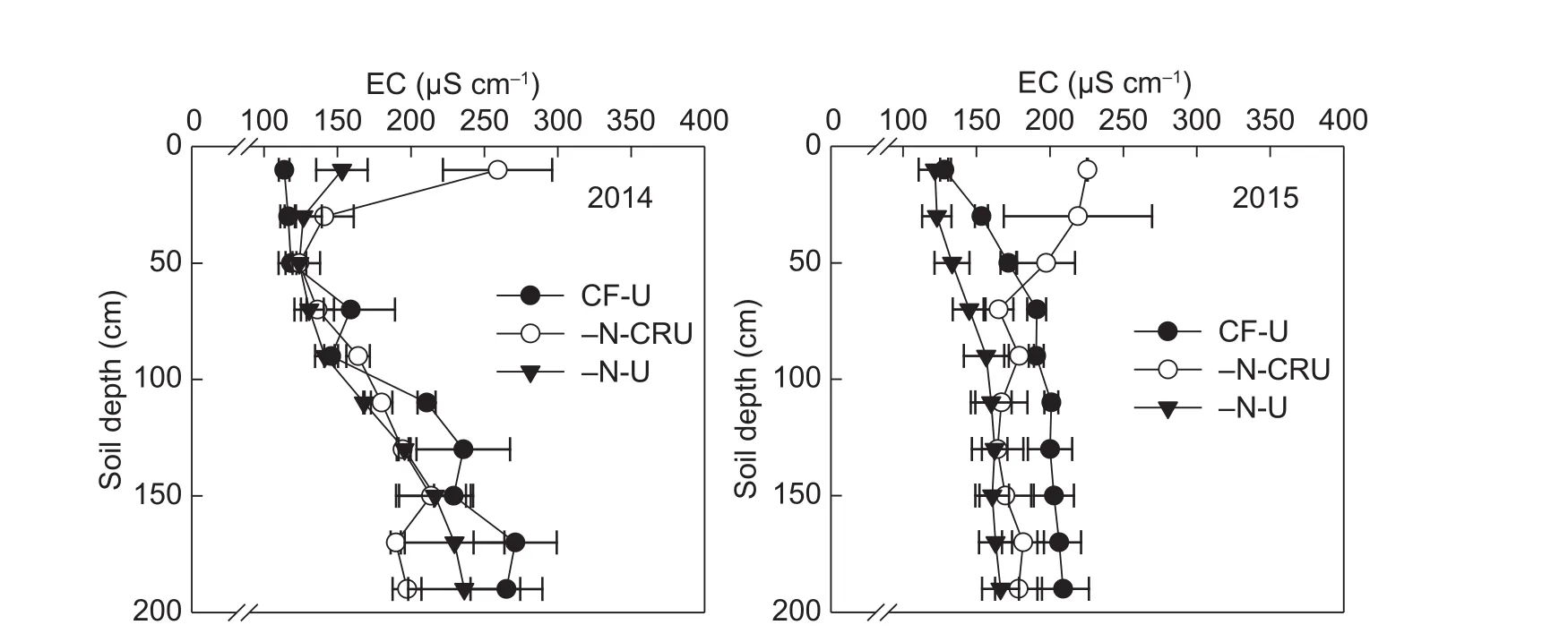
Fig. 6 The distribution of electrical conductivity (EC) in different soil layers under different N fertilization treatments at the end of the growing season in 2014 and 2015. CF-U, conventional N fertilizer rate (900 kg N ha–1 yr–1) added as urea (46% N); –N-CRU and –N-U refer to treatments where N was applied as controlled release urea and urea, respectively. In both treatments, the rates of N application were reduced by 25% in 2012–2013 and 2013–2014, and by 45% in 2014–2015, respectively. Bars indicate SD.
Many studies have shown that overuse of N fertilizers in other horticultural crops is also very common in China (Juet al.2007; Luet al.2016b; Zhouet al.2016). Juet al.(2006)reported that the mean N input from fertilizers was 842 kg N ha–1, and N surplus reached up to 721 kg N ha–1in the apple orchards in the North China Plain. A survey of 766 orchards in Shaanxi Province showed that the average annual N input from fertilizers was 927 kg N ha–1with a surplus N of 876 kg N ha–1. Among the different orchards, the highest N input rate (1 433 kg N ha–1) and the highest N surplus (1 187 kg N ha–1) were observed in a kiwifruit orchard (Zhaoet al.2014),indicating that there is great potential for decreasing the N application rate for these orchards. In our study over three consecutive years, we found that compared with the current application of N fertilizer, reducing the N application rate by 25–45% did not affect kiwifruit production.

Fig. 7 The relationship between nitrate N concentration and electrical conductivity (EC) in the soil at depths ranging from 0–200 cm. ** indicates significant linear correlation between nitrate N concentration and EC.
Excessive fertilization is a complicated institutional and economic issue (Sonntaget al.2005; Zhanget al.2015b).There are three main reasons for excessive fertilization by Chinese farmers: (1) The poor development of rational fertilizer recommendations in areas experiencing rapid expansion of horticultural production results in limited farmer awareness of plant N requirements (Juet al.2006;Gaoet al.2012); (2) Small landholding farmers are often driven by the economic benefits and ignore the harms of excessive fertilization to the environment. (3) No national/regional legislation governing the use of N in synthetic forms on agricultural land has been formulated to prevent the risk of N losses to environment (Luet al.2016a). In order to address the problem of over-fertilization, different regulations have been implemented in the European Union(EU) and the United States over the past decades, such as the EU-Nitrate Directive, and the Clean Water Act in the USA, and these regulations have resulted in significant reduction in surplus N from agriculture (Bellarbyet al.2015;van Grinsvenet al.2015). Fortunately, there has been a series of policies recently initiated by the government in order to tackle excessive fertilization in agriculture, such as “Zero Increase of Fertilizer by 2020” and “Clean Water Act” (Zhouet al.2016). However, reducing the N fertilizer rate in horticultural cropping systems by small landholder farmers in China is more complicated. Therefore, there is an urgent need to implement different technical, economic, and social methods to convince farmers to reduce the N fertilizer application rate for intensive horticultural systems in China.
4.2. Reduced N application and its environmental effects
In this study, we found that the reducing N application treatments by 25 and 45%, regardless of N form (i.e., U or CRU), significantly reduced the accumulation of nitrate-N in the 0–200 cm soil profile, especially at increasing depths(Fig. 5). The kiwi vine has a relatively shallow root system,and more than 78% of the roots are present at a soil depth of 0–40 cm. Only 15% of roots are present at a depth of 40–60 cm, and only a few roots are found at a depth of more than 100 cm (Wanget al.2010). The high nitrate-N accumulation at a depth of 100–200 cm (Fig. 5-D–F)clearly indicates severe loss of N through leaching. Other researchers have also shown that nitrate-N accumulation in soil increased significantly with increasing N application rates (Gheysariet al.2009; Quemadaet al.2013; Yanget al.2015). The average nitrate-N accumulation was as high as (2 155±330) kg N ha–1in the 0–400 cm soil layer of orchards in Chinese semi-humid regions (Zhouet al.2016).Therefore, reducing N fertilizer rate is urgent for preventing nitrate leaching loss in horticultural systems in China.
The high rate of nitrate loss through leaching in kiwifruit orchards is related to the intensive rainfalls during the summer season, which contribute about 70% of the annual precipitation, and flood irrigation (about 130 mm for each irrigation event) (Fig. 1). Compared to 2013 and 2015, the nitrate-N accumulation at a depth of 100–200 cm in 2014 was significantly higher. This could be explained by the high annual precipitation (especially the large amount of rainfall in September) in this year (Fig. 1). This result confirms that nitrate leaching not only depends on the total amount of annual precipitation, but also depends on its distribution(Gaoet al.2016; Zhouet al.2016).
Although soil nitrate-N was notably reduced under treatment with 45% less fertilizer input in 2015, its accumulation in the root zone (0–100 cm) at harvest was still higher than 500 kg N ha–1(Fig. 5-D–F), suggesting that the fertilizer N application rate could be further reduced without compromising production. This needs to be tested in future studies in the area.
4.3. Controlled release urea vs. common urea
The use of CRU can increase NUE as well as grain yield of different varieties of maize (Huet al.2013; Guoet al.2016).However, there are limited data available on the effects of its application in intensive orchards. In our study, we found that although the CRU treatment had no advantage over U on kiwifruit yield and quality when the same rate of N fertilizer was added, it increased the nitrate concentrations in the upper soil layers (0–100 cm) (Fig. 5-A–C). Compared to the –N-U treatment, the –N-CRU treatment increased the nitrate accumulation in the 0–200 cm soil profiles, especially at a depth of 0–100 cm (Fig. 5-D–F). A similar result was reported by Zhuet al.(2012). The main reason for this increase in nitrate accumulation is that CRU releases N slowly than common urea. As a result, we applied much less nitrate-N applied and accordingly much less nitrate-N leached into deep soil layers. Therefore, using CRU in addition to reducing N fertilizer rates could effectively contribute to mitigating nitrate loss from leaching losses and improve NUE.
The CRU used in our study was coated with polymers and was more expensive than U. Although the labor cost of fertilizer application was reduced because the number of topdressing times was reduced from 3 to 2 in our study, its economic benefit was still slightly decreased in comparison with U (Table 4). Thus, for smallholder farmers in China,other approaches, such as more affordable slow-release fertilizers, nitrification and urease inhibitors, and fertigation may be better choices.
5. Conclusion
Compared to conventional N fertilization, reducing the N application rate by 25% in 2012–2013 and 2013–2014 and by 45% in 2014–2015 had no adverse effects on the N nutrition of kiwi vines, single-fruit weight, fruit yield and quality, regardless of whether N was applied as a common or controlled-release urea fertilizer. The reduced N fertilization treatments increased PFPNand economic benefits to growers while reducing nitrate-N accumulation and its subsequent leaching to deeper soil layers. There were no significant differences in kiwifruit yield and quality between the two reduced N application treatments (–N-U and –N-CRU). However, the use of CRU decreased the loss of nitrate through leaching. This indicates that excessive N fertilization is a very serious problem in kiwi orchards of Qinling Mountains in Shaanxi Province, China. Different technical, economic and social measures are urgently needed to convince small landholder farmers to use less N fertilizer in horticultural systems.
Acknowledgements
This work was supported by the National Key Technologies R&D Program of China during the 12th Five-Year Plan period(2012BAD15B04), the National Natural Science Foundation of China (31372137, 41671295), and the project jointly supported by the Department for Environment, Food and Rural Affairs (Defra) of UK and the Ministry of Agriculture of China under the Sustainable Agriculture Innovation Network (SAIN).
AOAC (Association of Official Analytical Chemists). 1990.Official Methods of Analysis of the Association of Official Analytical Chemists. 15th ed. Association of Official Analytical Chemists, Arlington VA. pp. 1058–1059.
Aulakh M S, Malhi S S. 2005. Interactions of nitrogen with other nutrients and water: Effect on crop yield and quality, nutrient use efficiency, carbon sequestration, and environmental pollution.Advances in Agronomy,86, 341–409.
Bao S D. 2000.Chemical Analysis in Soil and Plant. China Agriculture Press, Beijing. (in Chinese)
Bellarby J, Surridge B, Haygarth P, Xin L. 2015. Inefficiency and environmental risks associated with nutrient use in agriculture within China and the UK. Policy Brief.
Cui S H, Shi Y L, Groffmanb P M, Schlesinger W H, Zhu Y G.2013. Centennial-scale analysis of the creation and fate of reactive nitrogen in China (1910–2010).Proceedings of the National Academy of Sciences of the United States of America,110, 2052–2057.
Davidson E A, Suddick E C, Rice C W, Prokopy L S. 2015.More food, low pollution (Mo Fo Lo Po): A grand challenge for the 21st century.Journal of Environmental Quality,44,305–311.
Dubois M, Gilles K, Hammiltron J K, Robers P A, Smith F.1951. A colorimetric method for the determination of sugars.Nature,168, 167–168.
Erisman W J, Sutton M A, Galloway J, Klimont Z, Winiwarter W. 2008. How a century of ammonia synthesis changed the world.Nature Geoscience,1, 636–639.
FAO. 2014. FAOSTAT Database. [2014-06-27]. http://faostat3.fao.org/faostat-gateway/go/to/browse/R/RF/E
Galloway J N, Leach A M, Bleeker A, Erisman J W. 2013.A chronology of human understanding of the nitrogen cycle.Philosophical Transactions of the Royal Society(B:Biological Sciences),368, 20130120.
Gao J B, Lu Y L, Chen Z J, Zhou J B. 2016. Nitrogen inputs and nitrate accumulation and movement in soil of kiwifruit orchards.Journal of Agro-Environment Science,35,322–328. (in Chinese)
Gao J J, Bai X L, Zhou B, Zhou J B. 2012. Soil nutrient content and nutrient balances in newly-built solar greenhouses in northern China.Nutrient Cycling in Agroecosystems,94,63–72.
Gheysari M, Mirlatify S M, Homaee M, Asadi M E, Hoogenboom G. 2009. Nitrate leaching in a silage maize field under different irrigation and nitrogen fertilizer rates.Water Resources Management,96, 946–954.
Van Grinsven H J M, Bouwman L, Cassman K G, Van Es H M,McCrackiin M L, Beusen A H. 2015. Losses of ammonia and nitrate from agriculture and their effect on nitrogen recovery in the European Union and the United States between 1900 and 2050.Journal of Environmental Quality,44, 356–367.
Guo J H, Liu X J, Zhang Y, Shen J L, Han W X, Zhang W F,Christie P, Goulding K W T, Vitousek P M, Zhang F S.2010. Significant acidification in major Chinese croplands.Science,327, 1008–1010.
Guo L W, Ning T Y, Nie L P, Li Z J, Lal R. 2016. Interaction of deep placed controlled-release urea and water retention agent on nitrogen and water use and maize yield.European Journal of Agronomy,75, 118–129.
Hu H Y, Ning T Y, Li Z J, Han H F, Zhang Z Z, Qin S J, Zheng Y H. 2013. Coupling effects of urea types and subsoiling on nitrogen-water use and yield of different varieties of maize in northern China.Field Crops Research,142, 85–94.
IFA (International Fertilizer Industry Association). 2013.Assessment of fertilizer use by crop at the global level 2010–2010/11. [2016-08-16]. http://www.fertilizer.org/ifa/statistic.asp
Ju X T, Kou C L, Christie P, Dou Z X, Zhang F S. 2007. Changes in the soil environment from excessive application of fertilizers and manures to two contrasting intensive cropping systems on the North China Plain.Environmental Pollution,145, 497–506.
Ju X T, Kou C L, Zhang F S, Christie P. 2006. Nitrogen balance and groundwater nitrate contamination: Comparison among three intensive cropping systems on the North China Plain.Environmental Pollution,143, 117–125.
Lu Y L, Chen Z J, Kang T T, Zhang X J, Bellarby J, Zhou J B.2016a. Land-use changes from arable crop to kiwi-orchard increased nutrient surpluses and accumulation in soils.Agriculture,Ecosystems and Environment,223, 270–277.
Lu Y L, Kang T T, Zhang X J, Gao J B, Chen Z J, Zhou J B.2016b. Evaluation of current fertilization status in kiwifruit orchards on the northern slope of Qinling Mountains: A case study of Yujiahe catchment, in Zhouzhi County.Journal of Plant Nutrient and Fertilizer,22, 380–387. (in Chinese)
Prasad M, Spiers T M. 1991. The effect of nutrient on the storage quality of kiwifruit (A review).Acta Horticuturae,297, 79–85.
Quemada M, Baranski M, Nobel-de Lange M N J, Vallejo A,Cooper J M. 2013. Meta-analysis of strategies to control nitrate leaching in irrigated agricultural systems and their effects on crop yield.Agriculture,Ecosystems and Environment,174, 1–10.
Rhoades J D. 1996. Salinity: Electrical conductivity and total dissolved solids. In: Sparks D L, ed.,Methods of Soil Analysis. Part 3. Chemical Methods. SSSA Book Series:No.5. SSSA and ASA, Madison, WI. pp. 417–435.
De Rosa D, Rowlings D W, Biala J, Scheer C, Basso B, Mc Green J, Grace P R. 2016. Effect of organic and mineral N fertilizers on N2O emissions from an intensive vegetable rotation.Biology and Fertility of Soils,52, 895–908.
Sonntag B H, Huang J K, Rozelle S, Skerrit J H. 2005. China’s agricultural and rural development in the early 21st century.In:ACIAR Monograph No. 116. Australian Centre for International Agricultural Research, Canberra, Australia.
Sui C L, Zhang M. 2014. Nitrogen recovery and fate od polymer coated 15n-urea fertilizers under corn-wheat rotation.Acta Agriculturae Boreali-occidentalis Sinica,23, 120–127. (in Chinese)
Timan D, Balzer C, Hill J, Befort B L. 2011. Global food demand and the sustainable intensification of agriculture.Proceedings of the National Academy of Sciences of the United States of America,108, 20260–20264.
Vitousek P M, Naylor R, Crews T, David M B, Drinkwater L E, Holland E, Nziguheba G. 2009. Nutrient imbalances in agricultural development.Science,324, 1519–1520.
Wang J, Tong Y A, Gao Y M. 2010. Study on the roots distribution and growth dynamics of kiwifruit in northern area of Qingling.Journal of Anhui Agricultural Science,38,8085–8087. (in Chinese)
Wang Y H, Qiu X K, Hu G Q, Dong Y J. 2011. Effect of controlled release fertilizer on nitrogen and phosphorus runoff losses from farmland in slope field.Journal of Soil and Water Conservation,25, 10–14. (in Chinese)
Xin L J, Li X B, Tan M H. 2012. Temporal and regional variations of China’s fertilizer consumption by crops during 1998–2008.Journal of Geophysical Research,22, 643–652.
Yang X L, Lu Y L, Tong Y A, Yin X F. 2015. A 5-year lysimeter monitoring of nitrate leaching from wheat-maize rotation system: Comparison between optimum N fertilization and conventional farmer N fertilization.Agriculture,Ecosystems& Environment,199, 34–42.
Zhang F S, Cui Z L, Fan M S, Zhang W F, Chen X P, Jiang R F. 2011. Integrated soil-crop management: Reducing environmental risk while increasing crop productivity and improving nutrient use efficiency in China.Journal of Environmental Quality,40, 1051–1057.
Zhang X, Davidson E A, Mauzerall D L, Searchinger T D, Dumas P, Shen Y. 2015a. Managing nitrogen for sustainable development.Nature,528, 51–59.
Zhang X, Mauzerall D L, Davidson E A. 2015b. The economic and environmental consequences of implementing nitrogenefficient technologies and management practices in agriculture.Journal of Environmental Quality,44, 312–324.
Zhao Z P, Yan S, Liu F, Wang X Y, Tong Y A. 2014. Analysis of nitrogen inputs and soil nitrogen loading in different kinds of orchards in Shaanxi Province.Acta Ecologica Sinica,34,5642–5649. (in Chinese)
Zhou J B, Xi J G, Chen Z J, Li S X. 2006. Leaching and transformation of nitrogen fertilizers in soil after application of N with irrigation: A soil column method.Pedosphere,16, 245–525.
Zhou J Y, Gu B J, Schlesinger W H, Ju X T. 2016. Significant accumulation of nitrate in Chinese semi-humid croplands.Scientific Reports,6, 25088.
Zhu Q, Zhang M, Ma Q. 2012. Copper-based foliar fertilizer and controlled release urea improved soil chemical properties,plant growth and yield of tomato.Scientia Horticulturae,143, 109–114.
 Journal of Integrative Agriculture2018年6期
Journal of Integrative Agriculture2018年6期
- Journal of Integrative Agriculture的其它文章
- Improve access to the EU market by identifying French consumer preference for fresh fruit from China
- Factors influencing hybrid maize farmers’ risk attitudes and their perceptions in Punjab Province, Pakistan
- Long-term grazing exclusion influences arbuscular mycorrhizal fungi and their association with vegetation in typical steppe of lnner Mongolia, China
- Soil microbial characteristics and yield response to partial substitution of chemical fertilizer with organic amendments in greenhouse vegetable production
- Ultrastructure of the sensilla on antennae and mouthparts of larval and adult Plutella xylostella (Lepidoptera: Plutellidae)
- In field control of Botrytis cinerea by synergistic action of a fungicide and organic sanitizer
